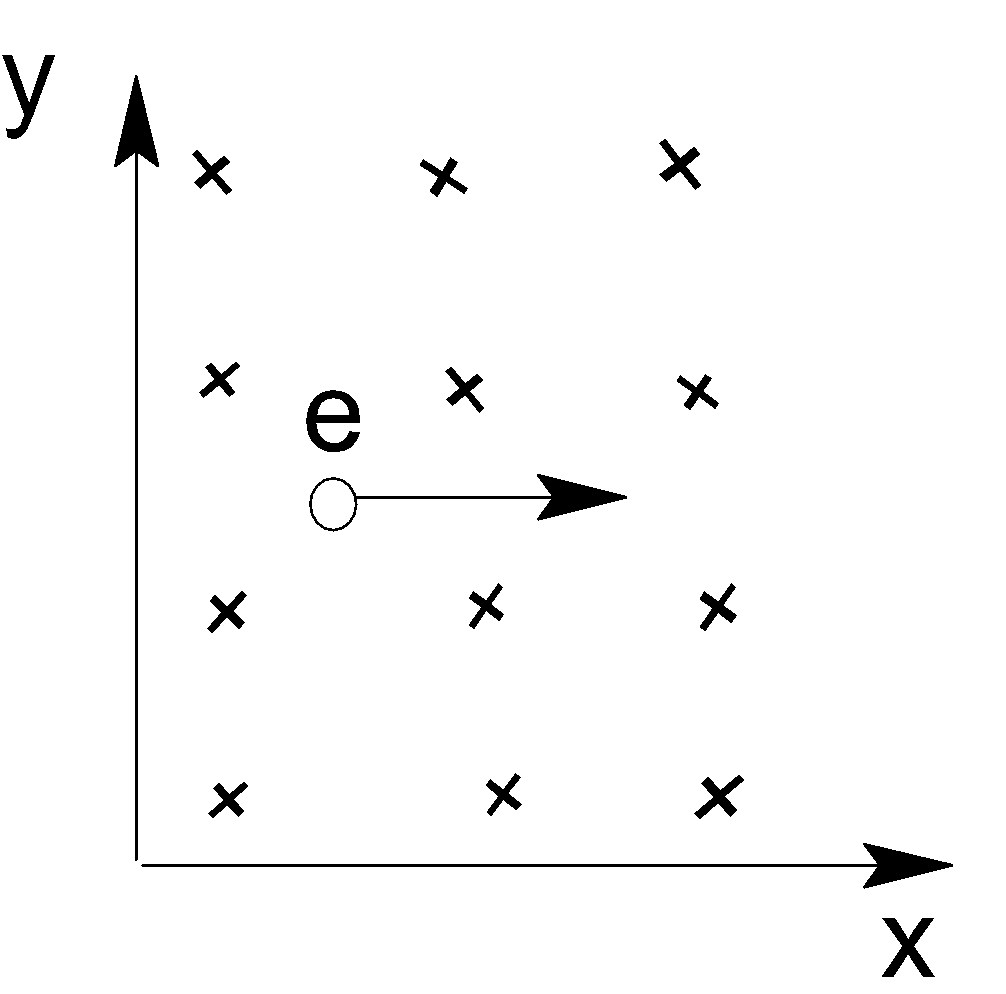
In the given figure, the electron enters into the magnetic field. It deflects in ……direction.

A.$(+)ve$$X-$direction
B.$(-)ve$ $X-$direction
C.$(+)ve$$Y-$direction
D.$(-)ve$$Y-$direction
Answer
223.8k+ views
Hint: In the given figure the electron is moving along a positive $x-$direction. And the conventional current moves in the negative $x-$direction. Therefore the deflection of electrons can be determined by Fleming’s left-hand thumb rule.
Complete answer:
In a uniform magnetic field, the magnetic force is always at right angles to the motion of the electron and as a result, the path of the electron in a uniform magnetic field is circular. The magnetic force acting on a charged particle is given by Fleming’s left-hand thumb rule.

Here the direction of the moving electron is along the positive $x-$direction and the direction of the current is along the negative $x-$direction. This is because the direction of conventional current is opposite to the direction of the flow of electrons. Now, according to Fleming’s left-hand thumb rule, the positively charged particle will be deflected in a positive $y-$direction.
But the electron is a negatively charged particle, so it will be reflected in a negative $y-$direction as it feels a force in this direction.
Thus, option (D) is correct.
Additional information: If the magnetic field and velocity are parallel to each other then the charged particle does not experience any magnetic force. Therefore the magnitude of force remains constant in the entire motion if no magnetic field is felt upon it.
Note:when a moving conductor is placed in a magnetic field, a current will be induced in it. The direction of the induced current can be determined by Fleming’s right-hand thumb rule. But when a current carrying is placed in a magnetic field, a magnetic force applies to it, the direction of magnetic force can be determined by Fleming’s left-hand thumb rule.
Complete answer:
In a uniform magnetic field, the magnetic force is always at right angles to the motion of the electron and as a result, the path of the electron in a uniform magnetic field is circular. The magnetic force acting on a charged particle is given by Fleming’s left-hand thumb rule.

Here the direction of the moving electron is along the positive $x-$direction and the direction of the current is along the negative $x-$direction. This is because the direction of conventional current is opposite to the direction of the flow of electrons. Now, according to Fleming’s left-hand thumb rule, the positively charged particle will be deflected in a positive $y-$direction.
But the electron is a negatively charged particle, so it will be reflected in a negative $y-$direction as it feels a force in this direction.
Thus, option (D) is correct.
Additional information: If the magnetic field and velocity are parallel to each other then the charged particle does not experience any magnetic force. Therefore the magnitude of force remains constant in the entire motion if no magnetic field is felt upon it.
Note:when a moving conductor is placed in a magnetic field, a current will be induced in it. The direction of the induced current can be determined by Fleming’s right-hand thumb rule. But when a current carrying is placed in a magnetic field, a magnetic force applies to it, the direction of magnetic force can be determined by Fleming’s left-hand thumb rule.
Recently Updated Pages
JEE Isolation, Preparation and Properties of Non-metals Important Concepts and Tips for Exam Preparation

Isoelectronic Definition in Chemistry: Meaning, Examples & Trends

Ionisation Energy and Ionisation Potential Explained

Iodoform Reactions - Important Concepts and Tips for JEE

Introduction to Dimensions: Understanding the Basics

Instantaneous Velocity Explained: Formula, Examples & Graphs

Trending doubts
JEE Main 2026: City Intimation Slip Releasing Today, Application Form Closed, Exam Dates, Syllabus & Eligibility

JEE Main 2026 Application Login: Direct Link, Registration, Form Fill, and Steps

Understanding the Angle of Deviation in a Prism

How to Convert a Galvanometer into an Ammeter or Voltmeter

Ideal and Non-Ideal Solutions Explained for Class 12 Chemistry

Hybridisation in Chemistry – Concept, Types & Applications

Other Pages
JEE Advanced Marks vs Ranks 2025: Understanding Category-wise Qualifying Marks and Previous Year Cut-offs

JEE Advanced 2026 - Exam Date (Released), Syllabus, Registration, Eligibility, Preparation, and More

JEE Advanced 2026 - Exam Date (Released), Syllabus, Registration, Eligibility, Preparation, and More

Dual Nature of Radiation and Matter Class 12 Physics Chapter 11 CBSE Notes - 2025-26

Understanding Electromagnetic Waves and Their Importance

Understanding Atomic Structure for Beginners




